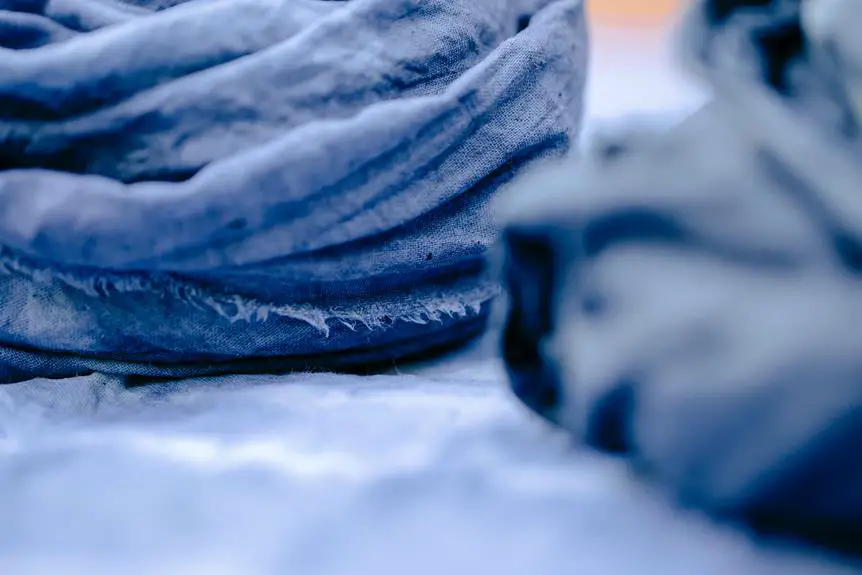Looking to reverse tie dye without ruining your fabric? Discover 5 fabric-friendly methods to achieve the perfect reverse tie dye look.
From bleaching techniques to ice dyeing and using bleach pens, you can master the art of reversing tie dye with ease.
Whether you're a seasoned crafter or just getting started, these techniques offer a professional touch to elevate your fabric creations.
Say goodbye to concerns about damaging your fabric and embrace the mastery of reverse tie dye.
Let's explore these innovative methods that will leave your fabrics looking fresh and vibrant.
Key Takeaways
- Properly protect fabric and smooth out wrinkles before applying bleach
- Experiment with different ice and dye placements for unique and organic patterns
- Use a bleach pen for precise and personalized designs
- Fold, twist, and bind fabric using Shibori techniques for intricate and stunning patterns
Bleach Reverse Tie Dye Technique
If you want to try the bleach reverse tie dye technique, you can achieve unique and stylish designs by using a few simple materials and following these easy steps.
Before starting the process, it's essential to ensure that you have proper fabric protection in place. Lay the fabric flat and smooth out any wrinkles to ensure an even application of the bleach.
When it comes to bleach application, it's crucial to use a spray bottle for a more controlled and even distribution. Dilute the bleach with water to achieve the desired effect, and always wear gloves and a mask to protect your skin and lungs from the harsh fumes. Remember to work in a well-ventilated area to minimize exposure.
After applying the bleach, monitor the fabric closely to achieve the desired level of color removal. Once you're satisfied with the result, rinse the fabric thoroughly to stop the bleaching process.
Ice Dyeing Method
Begin by laying out the fabric flat and smooth to prepare for the ice dyeing method. Ice dyeing is a fascinating natural dyeing method that produces stunning, watercolor-like effects on fabric. This technique involves placing ice on top of scrunched fabric and then sprinkling powdered dye over the ice, allowing it to melt and create unique patterns as it permeates the fabric.
To better understand the ice dyeing technique, consider the following table:
| Ice Dyeing Technique | Natural Dyeing Methods |
|---|---|
| Uses ice as a medium for dye | Utilizes natural dyes |
| Creates intricate patterns | Produces organic colors |
| Allows for artistic expression | Harnesses the power of nature |
Ice dyeing offers a creative way to reverse tie dye by adding vibrant colors to previously bleached or light-colored fabric. By scrunching the fabric and strategically placing the ice and dye, you can create personalized designs that are both intricate and visually captivating. Embrace the artistry of natural dyeing methods and experiment with this innovative technique to revitalize your fabric with stunning, one-of-a-kind patterns.
Reverse Tie Dye With Bleach Pen
To reverse tie dye with a bleach pen, carefully scrunch the fabric and strategically apply the bleach, allowing for personalized designs to be created, adding vibrant colors to previously dyed or light-colored fabric. Bleach pen application provides a precise method for removing fabric color and achieving unique patterns.
Here's how to effectively use a bleach pen for reverse tie dye:
- Prepare the Fabric: Lay the fabric flat and ensure it's clean and dry before beginning the reverse tie dye process.
- Protect Your Work Surface: Place a plastic or vinyl covering under the fabric to protect the work surface from bleach stains.
- Apply the Bleach Pen: Gently squeeze the bleach pen to release the bleach onto the scrunched fabric, creating the desired patterns or designs. Be careful not to oversaturate the fabric.
- Allow for Color Change: Let the bleach sit on the fabric for the desired amount of time, monitoring the color change closely. Rinse the fabric thoroughly with cold water once the desired effect is achieved.
Shibori Reverse Tie Dye
Explore Shibori reverse tie dye techniques by folding, twisting, and binding fabric to create intricate patterns and designs using traditional Japanese methods. Shibori folding involves a variety of techniques such as kumo (twisting and binding), itajime (folding and clamping), and arashi (wrapping around a pole). These methods result in mesmerizing patterns that can add a unique touch to your fabric.
When using natural dyes like indigo, Shibori reverse tie dyeing can produce stunning, rich shades of blue.
To start, prepare your fabric by washing and leaving it damp. Then, experiment with different folding and binding techniques to create your desired pattern. Once the fabric is secured, immerse it in a natural indigo dye bath and allow it to oxidize to achieve the vibrant blue color. Rinse the fabric thoroughly and remove the bindings to reveal the intricate patterns created through Shibori folding.
Traditional patterns such as kanoko (resembling fawn spots) and karamatsu (resembling pine needles) are popular choices when practicing Shibori reverse tie dye. With practice and patience, you can master the art of Shibori reverse tie dye and create visually stunning designs on your fabrics.
Ombre Reverse Tie Dye
To achieve an ombre effect in reverse tie dye, start by securing the fabric in a way that allows for gradual color blending, building on the folding techniques discussed in the previous section on Shibori reverse tie dye. This method will enable you to create a stunning transition of colors across the fabric.
Here are some essential steps for achieving an ombre reverse tie dye effect:
- Select the dye colors: Choose two or more colors that blend well together for a seamless ombre effect.
- Prepare the dye solution: Mix the dye according to the manufacturer's instructions, ensuring proper saturation and consistency for optimal color blending.
- Apply the dye gradually: Start by applying the darkest color at one end of the fabric and gradually transition to the lighter color(s) towards the other end, allowing the colors to blend naturally.
- Blend the colors: Use a brush or sponge to gently blend the colors where they meet, creating a smooth ombre transition.
Remember that proper fabric care, including rinsing and washing, is crucial to maintain the vibrancy of the ombre effect while preserving the fabric's integrity.
Frequently Asked Questions
Can I Use the Reverse Tie Dye Techniques on Synthetic Fabrics Like Polyester and Nylon?
Yes, you can use the reverse tie dye techniques on synthetic fabrics like polyester and nylon. Ensure fabric compatibility and follow specific instructions for color transformation. It's important to consider the material's composition for successful results.
Is It Possible to Reverse Tie Dye Dark-Colored Clothing to Achieve a Lighter Color?
Yes, it's possible to reverse tie dye dark-colored clothing to achieve a lighter color. Lightening denim and color restoration techniques can help you achieve this. Follow specific instructions for best results on various fabric types.
Are There Any Special Considerations for Reversing Tie Dye on Delicate Fabrics Like Silk or Chiffon?
When reversing tie dye on delicate fabrics like silk or chiffon, special care is crucial. Silk requires gentle handling to avoid damage, while chiffon may benefit from specific techniques to preserve its delicate nature.
Can I Use Natural Dyes Instead of Bleach for the Reverse Tie Dye Techniques?
You can absolutely use natural dyes as eco-friendly alternatives for reverse tie dye techniques. Consider plant-based pigments for color extraction, providing sustainable and non-bleach options. This approach is both effective and environmentally conscious.
How Do I Prevent the Colors From Bleeding or Fading After Using the Reverse Tie Dye Methods?
To prevent color bleeding and fading after reverse tie dye, use vinegar or salt in the wash to set the colors. Wash in cold water and air dry to minimize fading. Follow garment care instructions for best results.
- Spunbond vs. Spunlace: What’s the Difference in Nonwoven Fabrics? - July 11, 2025
- The Ultimate Comparison: Woven vs. Nonwoven Fabric Properties - July 11, 2025
- Nonwoven Polypropylene Safety: A Full Breakdown - July 11, 2025







